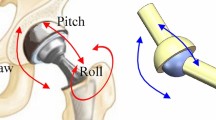Abstract
Humanoids are being applied into society gradually in the aspect of human–robot interaction recently. The human spine plays an important role when performing natural human upper body postures. However, most of the humanoids only show tense body postures due to the limitations of their simple mechanical structures. We investigated that the human natural spine postures can be imitated by serially connected rigid links with a few joints by the analysis of human spine motion. In this report, we proposed a robotic spine composed of parallelogram actuation modules, and built a prototype. We also investigated the natural spinal postural appearances which are realized by the prototype.








Similar content being viewed by others
Explore related subjects
Discover the latest articles and news from researchers in related subjects, suggested using machine learning.References
Nishio S, Ishiguro H, Hagita N (2007) Geminoid: teleoperated android of an existing person. INTECH Open Access Publisher, Vienna, pp 343–352
Endo N, Takanishi A (2011) Development of whole-body emotional expression humanoid robot for adl-assistive rt services. JRM 23(6):969–977
Kanda T, Ishiguro H, Ono T, Imai M, Nakatsu R (2002) Development and evaluation of an interactive humanoid robot “Robovie”. In: Proceedings IEEE international conference on robotics and automation, vol 2. pp 1848–1855
Kozuki T, Hirose T, Shirai T, Nakashima S, Asano Y, Kakiuchi Y, Okada K, Inaba M (2016) Skeletal structure with artificial perspiration for cooling by latent heat for musculoskeletal humanoid kengoro. In: Proceedings of the 2016 IEEE/RSJ International Conference on Intelligent Robots and Systems, pp 2135–2140
Gardner Morse M, Stokes IA, Laible JP (1995) Role of muscles in lumbar spine stability in maximum extension efforts. J Orthop Res 13(5):802–808
Andrei SR, Nakamura Y, Nakata Y, Ishiguro H (2016) Design strategy for robotic spines of androids with a natural postural appearance. In: 2016 IEEE-RAS international conference on humanoid robots, pp 312–317
Ryu H, Nakata Y, Nakamura Y, Ishiguro H (2016) Adaptive whole-body dynamics: an actuator network system for orchestrating multijoint movements. IEEE RAM 23(3):85–92
Van Varseveld RB, Bone GM (1997) Accurate position control of a pneumatic actuator using on/off solenoid valves. IEEE/ASME TMECH 2(3):195–204
Paul AK, Mishra JE, Radke MG (1994) Reduced order sliding mode control for pneumatic actuator. IEEE TCST 2(3):271–276
Linnett JA, Smith MC (1989) An accurate low-friction pneumatic position control system. Proc Inst Mech Eng B 203(3):159–165
Noritsugu T (1986) Development of PWM mode electro-pneumatic servomechanism. I: speed control of a pneumatic cylinder. J Fluid Control 17(1):65–80
Acknowledgements
This work was partially supported by Japan Society for the Promotion of Science Grants-in-Aid for Scientific Research Grant numbers JP26730136 and JP26700026.
Author information
Authors and Affiliations
Corresponding author
Additional information
This work was presented in part at the 22nd International Symposium on Artificial Life and Robotics, Beppu, Oita, January 19–21, 2017.
About this article
Cite this article
Yu, S., Nakata, Y., Nakamura, Y. et al. A design of robotic spine composed of parallelogram actuation modules. Artif Life Robotics 22, 477–482 (2017). https://doi.org/10.1007/s10015-017-0383-0
Received:
Accepted:
Published:
Issue Date:
DOI: https://doi.org/10.1007/s10015-017-0383-0
Keywords
Profiles
- Shiqi Yu View author profile




